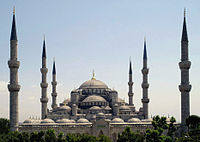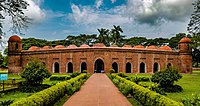Islamic culture
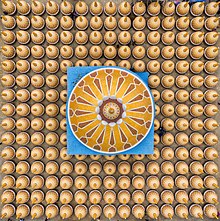
| Part ofa serieson |
| Islamic culture |
|---|
| Architecture |
| Art |
| Clothing |
| Holidays |
| Literature |
| Music |
| Theatre |
| Part ofa serieson |
| Islam |
|---|
 |
Islamic cultureorMuslim culturerefers to the historic cultural practices that developed among the various peoples living in theMuslim world.These practices, while not always religious in nature, are generally influenced by aspects ofIslam,particularly due to the religion serving as an effective conduit for the inter-mingling of people from different ethnic/national backgrounds in a way thatenabled their cultures to come togetheron the basis of a commonMuslimidentity. The earliest forms of Muslim culture, from theRashidun Caliphateto theUmayyad Caliphateand the earlyAbbasid Caliphate,was predominantly based on the existing cultural practices of theArabs,theByzantines,and thePersians.However, as theIslamic empiresexpanded rapidly, Muslim culture was further influenced and assimilated much from theIranic,Caucasian,Turkic,Indian,Malay,Somali,Berber,andIndonesiancultures.


Owing to a variety of factors, there arevariations in the application of Islamic beliefsin different cultures and traditions.[1]
Language and literature
[edit]Arabic
[edit]Arabic literature(Arabic:الأدب العربي/ALA-LC:al-Adab al-'Arabī) is the writing, bothproseandpoetry,produced by writers in theArabic language.The Arabic word used for literature is"Adab",which is derived from a meaning ofetiquette,and which implies politeness, culture and enrichment.
Arabic literature emerged in the 5th century with only fragments of the written language appearing before then. TheQur'an,(the holy book of Islam) widely regarded by people as the finest piece of literature in theArabic language,[2]would have the greatest lasting effect onArabic cultureand its literature. Arabic literature flourished during theIslamic Golden Age,but has remained vibrant to the present day, with poets and prose-writers across the Arab world, as well as rest of the world, achieving increasing success.
Persian/Iranic
[edit]Persian literaturecomprises oral compositions and written texts inWestern Iranian languages,particularlyMiddleandNew Persian,and it is one of the world's oldestliteratures.[3][4][5]It spans over two-and-a-half millennia. Its sources have been withinGreater Iranincluding present-dayIran,Iraq,Syria,Afghanistan,theCaucasus,andTurkey,regions ofCentral Asiasuch asTajikistan,andSouth Asia,where Persian has historically been either the native or official language. For instance,Rumi,one of the best-loved Persian poets, was born inBalkh(in what is now Afghanistan) orVakhsh(in what is now Tajikistan), wrote in Persian, and lived inKonya,then the capital of theSeljuksin Anatolia. TheGhaznavidsconquered large territories in Central andSouth Asiaand adopted Persian as their court language. There is thus Persian literature from Iran, Mesopotamia,Azerbaijan,the widerTranscaucasus,Anatolia, western parts ofPakistan,Bangladesh,India, Tajikistan and other parts of Central Asia.
Not all Persian literature is written in Persian; works written by ethnicPersiansin other languages, such asGreekandArabic,are sometimes included. At the same time, not all literature written in Persian is written by ethnic Persians or Iranians; Turkic, Caucasian, and Indian poets and writers have also used the Persian language in the environment of Persianate societies.
Described as one of the great literatures of humanity,[6]includingGoethe's assessment of it as one of the four main bodies of world literature,[7]Persian literature has its roots in surviving works of Middle andOld Persian,the latter of which date back as far as 522 BCE, the date of the earliest survivingAchaemenidinscription, theBehistun Inscription.The bulk of surviving Persian literature, however, comes from the times following theMuslim conquest of Persiac. 650.After theAbbasid Caliphatecame to power in 750, Persians became its scribes and bureaucrats and, increasingly, also its writers and poets. The New Persian language literature arose and flourished inKhorasanandTransoxianabecause of political reasons, early Iranian dynasties such as theTahiridsandSamanidsbeing based in Khorasan.[8]
Persian poets such asFerdowsi,Saadi Shirazi,Hafiz Shirazi,Attar of Nishapur,Nizami Ganjavi,[9]Rumi[10]andOmar Khayyamare also known in the West and have influenced the literature of many countries.
Indic
[edit]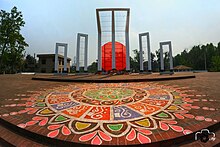
For a thousand years, since the invasion of India by theGhaznavids,the Persian–Islamic culture of the eastern half of the Islamic world started to influence the Indian culture. Persian was the official language of most Indian empires such as theGhaznavids,theDelhi Sultanate,theBengal Sultanate,theDeccan Sultanates(such as theQutb Shahi dynasty) and theMughal Empire.Persian artistic forms in literature and poetry such asghazalshave come to significantly affectUrduand other Indian literature. More Persian literature was produced in India than in the Iranian world. As late as the 20th century,Allama Iqbalchose Persian for some of his major poetic works. The first Persian language newspaper was also published in India, given that printing machines were first implemented in India.
InBengal,Muslim writers were exploring different themes through Islamic narratives and epics such as culture, cosmology, love and history. Starting fromShah Muhammad Saghirin the 14th century, Muslim writers began to enrich the Bengali language for over 600 years, often being actively supported and promoted by the rulers themselves.[11]The early 20th century brought a new era for Bengali Islamic literature, with its most notable poetKazi Nazrul Islamespousing intense rebellion against colonialism and oppression, in addition to writing a highly acclaimed collection of Bengalighazals.Sultana's DreambyBegum Rokeya,anIslamic feminist,is one earliest works offeminist science fiction.UNESCOdecided to observe 21 February asInternational Mother Language Day.[12]The UNESCO General Conference took the decision that took effect on 17 November 1999,[13]
Turkic
[edit]From the 11th century, there was a growing body of Islamic literature in theTurkic languages.However, for centuries to come the official language in Turkish-speaking areas would remain Persian. In Anatolia, with the advent of the Seljuks, the practise and usage of Persian in the region would be strongly revived. A branch of theSeljuks,theSultanate of Rum,took Persian language, art and letters to Anatolia.[14]They adopted Persian language as theofficial languageof the empire.[15]TheOttomans,which can "roughly" be seen as their eventual successors, took this tradition over. Persian was the official court language of the empire, and for some time, the official language of the empire,[16]though the lingua franca amongst common people from the 15th/16th century would become Turkish as well as having laid an active "foundation" for the Turkic language as early as the 4th century (seeTurkification). After a period of several centuries,Ottoman Turkishhad developed towards a fully accepted language of literature, which was even able to satisfy the demands of a scientific presentation.[17]However, the number of Persian and Arabic loanwords contained in those works increased at times up to 88%.[17]However, Turkish was proclaimed the official language of theKaramanidsin the 17th century, though it did not manage to become the official language in a wider area or larger empire until the advent of the Ottomans. With the establishment of theOttoman Empire,Ottoman Turkishgrew in importance in both poetry and prose becoming, by the beginning of the 18th century, the official language of the Empire. Unlike India, where Persian remained the official and principal literary language of both Muslim and Hindu states until the 19th century.
Art
[edit]


PublicIslamic artis traditionally non-representational, except for the widespread use of plant forms, usually in varieties of the spirallingarabesque.These are often combined withIslamic calligraphy,geometric patternsin styles that are typically found in a wide variety of media, from small objects in ceramic or metalwork to large decorative schemes in tiling on the outside and inside of large buildings, includingmosques.However, there is a long tradition inIslamic artof the depiction of human and animal figures, especially in painting and small anonymousrelieffigures as part of a decorative scheme. Almost allPersian miniatures(as opposed to decorativeilluminations) include figures, often in large numbers, as do their equivalents in Arab, Mughal andOttoman miniatures.But miniatures in books ormuraqqaalbums were private works owned by the elite. Larger figures inmonumental sculptureare exceptionally rare until recent times, andportraitureshowing realistic representations of individuals (and animals) did not develop until the late 16th century in miniature painting, especiallyMughal miniatures.Manuscripts of the Qur'an and other sacred texts have always been strictly kept free of such figures, but there is a long tradition of thedepiction of Muhammadand other religious figures in books of history and poetry; since the 20th century Muhammad has mostly been shown as though wearing a veil hiding his face, and many earlier miniatures were overpainted to use this convention.[18]
Depiction of animate beings
[edit]
Some interpretations of Islam include a ban of depiction of animate beings, also known as aniconism. Islamic aniconism stems in part from the prohibition of idolatry and in part from the belief that creation of living forms is God's prerogative. Although theQurandoes not explicitly prohibit visual representation of any living being, it uses the wordmusawwir(maker of forms, artist) as an epithet of God. The corpus ofhadith(sayings attributed to the Islamic prophetMuhammad) contains more explicit prohibitions of images of living beings, challenging painters to "breathe life" into their images and threatening them with punishment on theDay of Judgment.[19][20]Muslims have interpreted these prohibitions in different ways in different times and places. ReligiousIslamic arthas been typically characterized by the absence of figures and extensive use ofcalligraphic,geometricandabstract floralpatterns. However, representations of Muhammad (in some cases, with his face concealed) and other religious figures are found in some manuscripts from lands to the east of Anatolia, such as Persia and India. These pictures were meant to illustrate the story and not to infringe on the Islamic prohibition of idolatry, but many Muslims regard such images as forbidden.[19]In secular art of the Muslim world, representations of human and animal forms historically flourished in nearly all Islamic cultures, although, partly because of opposing religious sentiments, figures in paintings were often stylized, giving rise to a variety of decorative figural designs.[20]
Calligraphy
[edit]Islamic calligraphy is the artistic practice ofhandwritingandcalligraphy,based upon theAlpha betin the lands sharing a common Islamic cultural heritage. It includesArabic Calligraphy,Ottoman,andPersian calligraphy.[21][22]It is known inArabicaskhatt Islami(خط اسلامي), meaning Islamic line, design, or construction.[23]
The development of Islamic calligraphy is strongly tied to theQur'an;chapters and excerpts from the Qur'an are a common and almost universal text upon which Islamic calligraphy is based. However, Islamic calligraphy is not limited to strictly religious subjects, objects, or spaces. Like allIslamic art,it encompasses a diverse array of works created in a wide variety of contexts.[24]The prevalence of calligraphy in Islamic art is not directly related to its non-figural tradition; rather, it reflects the centrality of the notion of writing and written text in Islam.[25]Muhammad is said to have said: "The first thing God created was the pen."[26]
Islamic calligraphy developed from two major styles:KuficandNaskh.There are several variations of each, as well as regionally specific styles. Islamic calligraphy has also been incorporated into modern art beginning with the post-colonial period in the Middle East, as well as the more recent style ofcalligraffiti.
Architecture
[edit]Islamic architectureis the range ofarchitectural stylesofbuildingsassociated withIslam.It encompasses both secular and religious styles from the earlyhistory of Islamto the present day. Early Islamic architecture was influenced byRoman,Byzantine,Persianand all other lands which the Muslims conquered in the 7th and 8th centuries.[27][28]Further east, it was also influenced byChineseandIndian architectureas Islam spread to theSoutheast Asia.Later it developed distinct characteristics in the form of buildings, and the decoration of surfaces withIslamic calligraphyand geometric and interlace patterned ornament. The principal Islamic architectural types for large or public buildings are: theMosque,theTomb,thePalaceand theFort.From these four types, the vocabulary of Islamic architecture is derived and used for other buildings such aspublic baths,fountainsand domestic architecture.[29][30]
-
Northeast entrance toDelhi, India'sJama Masjid.
-
TheGreat Mosque of Kairouanalso called the Mosque of Uqba is at the same time the oldest mosque in North Africa (founded in 670 and still used as a place of worship) and one of the most important monuments of Islamic civilisation,[31][32]situated inKairouan,Tunisia.
-
The fortress-palace ofAlhambra,built in the 11th century, is a large monument and a popular tourist attraction.
-
Istanbul'sSultan Ahmed Mosquewas completed in 1616.
-
The 15th-centurySixty Dome MosqueofKhalifatabadinBangladeshis an example of theBengal Sultanatearchitecture.
Elements of Islamic style
[edit]Islamic architecture may be identified with the following design elements, which were inherited from the first mosque built byMuhammadinMedina,as well as from other pre-Islamic features adapted from churches and synagogues.
- Large courtyards often merged with a central prayer hall (originally a feature of theMasjid al-Nabawi).
- Minaretsor towers (which were originally used as torch-lit watchtowers for example in theGreat Mosque of Damascus;hence the derivation of the word from the Arabicnur,meaning "light" ). The oldest standing minaret in the world is the minaret of theGreat Mosque of Kairouan(inTunisia);[33][34]erected between the 2nd and the 3rd century, it is a majestic square tower consisting of three superimposed tiers of gradual size and decor.
- Amihrabor niche on an inside wall indicating the direction toMecca.This may have been derived from previous uses of niches for the setting of thetorahscrolls inJewishsynagogues orMehrab(Persian:مِهراب) of PersianMitraismculture or thewikt:haikalofCopticchurches.
- Domes (the earliest Islamic use of which was in the 8th-century mosque of Medina).
- Use ofiwansto intermediate between different sections.
- Use of geometric shapes and repetitive art (arabesque).
- Use of decorativeArabic calligraphy.
- Use of symmetry.
- Ablution fountains.
- Use of bright colour.
- Focus on the interior space of a building rather than the exterior.
Theatre
[edit]
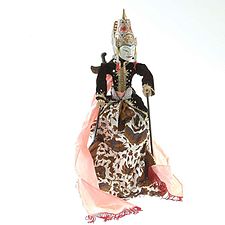
Whilst theatre is permitted by Islam,[35]Islam does not allow for any performances to depict God,Muhammad,his companions, theangelsor matters detailed in the religion that are unseen.
The most popular forms of theatre in themedieval Islamic worldwerepuppettheatre (which included hand puppets,shadow playsandmarionetteproductions) and livepassion playsknown asta'ziya,where actors re-enact episodes fromMuslim history.In particular,Shia Islamicplaysrevolved around theshaheed(martyrdom) ofAli's sonsHasan ibn AliandHusayn ibn Ali.Live secular plays were known asakhraja,recorded in medievaladabliterature, though they were less common than puppetry andta'ziehtheatre.[36]
One of the oldest, and most enduring, forms of puppet theatre is theWayangofIndonesia.Although it narrates primarily pre-Islamic legends, it is also an important stage for Islamic epics such as the adventures of Amir Hamzah (pictured). Islamic Wayang is known asWayang SadatorWayang Menak.
Karagoz,the Turkish Shadow Theatre has influenced puppetry widely in the region. It is thought to have passed fromChinaby way ofIndia.Later it was taken by theMongolsfrom the Chinese and transmitted to the Turkish peoples of Central Russia. Thus the art of Shadow Theatre was brought toAnatoliaby the Turkish people emigrating from Central Asia. Other scholars claim that shadow theatre came to Anatolia in the 16th century fromEgypt.The advocates of this view claim that when Yavuz Sultan Selim conquered Egypt in 1517, he saw shadow theatre performed during an extacy party put on in his honour.Yavuz Sultan Selimwas so impressed with it that he took the puppeteer back to his palace in Istanbul. There his 47-year-old son, later SultanSuleyman the Magnificent,developed an interest in the plays and watched them a great deal. Thus shadow theatre found its way into the Ottoman palaces.[37]
In other areas the style of shadow puppetry known askhayal al-zill– an intentionally metaphorical term whose meaning is best translated as 'shadows of the imagination' or 'shadow of fancy' survives. This is a shadow play with live music.. "the accompaniment of drums, tambourines and flutes...also..." special effects "– smoke, fire, thunder, rattles, squeaks, thumps, and whatever else might elicit a laugh or a shudder from his audience"[38]
InIranpuppets are known to have existed much earlier than 1000, but initially only glove and string puppets were popular in Iran.[39]Other genres of puppetry emerged during theQajarera (18th–19th century) as influences from Turkey spread to the region.Kheimeh Shab-Baziis a Persian traditional puppet show which is performed in a small chamber by a musical performer and astorytellercalled amorshedornaghal.These shows often take place alongside storytelling in traditional tea and coffee-houses (Ghahve-Khave). The dialogue takes place between the morshed and the puppets. Puppetry remains very popular in Iran, the touring operaRostam and Sohrab puppet operabeing a recent example.
TheRoyal Opera HouseinMuscat, Oman.It is considered to be the first opera house linking Islamic culture with classical music.
Following theindependence of Pakistanin 1947, religion-based nationalism was strong and affected the theatre in both wings of the country. InEast Pakistan(modern-day Bangladesh), playwrights emerged such as Ibrahim Khan (1894–1978), Ibrahim Khalil (b. 1916), Akbar ad-Din (1895–1978) and others. These playwrights would create plays related to the Islamic history ofthe subcontinentand Middle East, glorifying past Muslim rulers as well as the history of thePakistan Movement.[40]
Dance
[edit]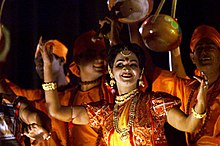
Many forms of dancing arts are practised in Muslim cultures, both in religious[41]and secular contexts (such as folk and tribal dances, court dances, dances of celebration during weddings and festivals,belly dancing,etc.).
Some scholars of Islamicfiqhpronounced gender based rulings on dance, making it permissible for women within a female only environment, as is often performed at celebrations,[42]but discouraging men to engage in it.[43]Other classical authorities includingAl-GhazzaliandAl-Nawawiallow it without this distinction, but criticised dancing which is "languid" or excites carnal lusts.[44][45]
Most of the religious orders (tariqa) which dominate traditional Muslim religious life practice ritualised forms of dance in the context ofdhikrceremonies.Dhikr,"recollection" (of God) is a meditative form of worship different from ritual prayer where the seeker focuses all of his senses and thoughts on God in the hope of attainingmaarifat(experiential knowledge of God) and triggering mystic states within him- or herself.Dhikrcan be performed individually or with like-minded followers under the direction of asheikh,and can involve silent meditation or repetition and visualisation of sacred words such as the99 names of Godor Quranic phrases, and may be done at rest or with rhythmic movements and controlling one's breath. Traditional Islamic orders have developed varieddhikrexercises including sometimes highly elaborate ritual dances accompanied by Sufi poetry and classical music.
Al-Ghazzalidiscussed the use of music and dancing indhikrand the mystical states it induces in worshippers, as well as regulating the etiquette attached to these ceremonies, in his short treatise on Islamic spiritualityThe Alchemy of Happinessand in his highly influential workThe Revival of the Religious Sciences.Al-Ghazzali emphasized how the practices of music and dance are beneficial to religious seekers, as long as their hearts are pure before engaging in these practices.[46]
Notable examples include theMevlevi Orderfounded byJalaluddin Rumi,which was the main Sunni order of theOttoman Empire,and itssamaritual (known in the West as "thewhirling dervishes").[47]The Mevlevi order, its rituals and Ottoman classical music has been banned inTurkeythrough much of the 20th century as part of the country's drive towards secular "modernisation", and the order's properties have been expropriated and the country's mosques put out of its control, which has radically diminished its influence in modern Turkey. In 2008,UNESCOconfirmed the "MevleviSama Ceremony "ofTurkeyas one of theMasterpieces of the Oral and Intangible Heritage of Humanity,[48]and the practice is now regaining interest.
InEgyptand theLevant,the Mevlevi form ofsamais known astannouraand has been adopted (with some modifications) by other Sufi orders as well.
TheChishtiorder, traditionally the dominant Islamic institution inAfghanistanand theIndian subcontinentand the most ancient of the major Sufi orders, also practices forms ofsamasimilar to the Mevlevis, as well as other forms of devotional dance. The order is strongly associated with the development ofHindustani classical musicand semi-classical devotional genres such asqawwalithrough famed pioneer figures such asAmir Khusrow.The Chishti order remains one of the largest and strongest Muslim religious orders in the world by far, retaining a vast influence on the spirituality and culture of around 500 million Muslims living in the Indian subcontinent.
Other examples of devotional dance are found in theMaghrebwhere it is associated withgnawamusic, as well as Sub-Saharan Africa and South-East Asia. TheNaqshbandiorder, predominant amongIran's Sunni minority, is a notable exception in that they do not use music and dancing in the context ofdhikr.
In addition to these strictly religious forms of dance, colourful dancing processions traditionally take place in Muslim communities during weddings and public celebrations such asMawlid,Eid el-Adha,and so on. Many Islamic cultures have also developed classical forms of dance in the context for instance ofMughal,Ottoman,PersianandJavanesecourt cultures, as well as innumerable local folk and tribal dances (for instance amongstBedouin,TuaregandPashtopeoples), and other forms of dance used for entertainment or sometimes healing such as belly dancing (principally associated with Egyptian culture).
Althoughtariqasand their rituals have been an omnipresent part of Muslim life for most of Islam's history and were largely responsible for the spread of Islam throughout the world, their following and influence has sharply declined since the late 19th century, having been vigorously opposed and combated in turns by theFrenchandBritishcolonial administrations and by Muslim modernists and secularists likeKemal Atatürk,and in recent decades have been the target of vocal opposition by the fundamentalistWahhabisect promoted bySaudi Arabia(where most of the heritage associated withSufismandtariqawas physically destroyed by the state in the 1930s). Wahhabi militant groups such asISISand theTalibanare repeatedly targetingdhikrceremonies in terrorist attacks, notably inEgyptandPakistan.[49][50]
Music
[edit]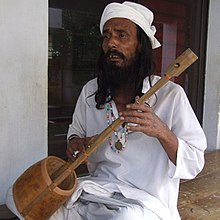
Many Muslims are very familiar to listening to music. The classic heartland ofIslamisArabiaas well as other parts of theMiddle East,North AfricaandCentral Asia.BecauseIslamis a multicultural religion, the musical expression of its adherents is diverse.
TheSeljuk Turks,a nomadic tribe that converted to Islam, conqueredAnatolia(nowTurkey), and held theCaliphateas theOttoman Empire,also had a strong influence on Islamic music. SeeTurkish classical music.
Sub-SaharanAfrica,India,and theMalay Archipelagoalso have large Muslim populations, but these areas have had less influence than the heartland on the various traditions of Islamic music. ForSouth India,see:Mappila Songs,Duff Muttu.
All these regions were connected by trade long before the Islamic conquests of the 7th century and later, and it is likely that musical styles travelled the same routes as trade goods. However, lacking recordings, we can only speculate as to the pre-Islamic music of these areas. Islam must have had a great influence on music, as it united vast areas under the first caliphs, and facilitated trade between distant lands. Certainly theSufis,brotherhoods of Muslimmystics,spread their music far and wide.
Alauddin Khan,Ali Akbar Khan,andGul Mohammad Khanwere notableBengali Muslimexponents ofclassical musicandRuna Lailabecame widely acclaimed for her musical talents across South Asia in the field of modern music.[51]Nazrul Sangeetis the collection of 4,000 songs andghazalswritten byKazi Nazrul Islam.See articles onJari gan,O Mon Romzaner Oi Rozar Sheshe,BhawaiyaandBhatiyali.
See articles onEid ul-Fitr,Eid ul-Adha,Ashurah(see alsoHosayandTabuik),Mawlid,Lailat al MirajandShab-e-baraat.
Family life
[edit]
In a Muslim family, the birth of a child is attended with some religious ceremonies. Immediately after the birth, the words ofAdhanis pronounced in the right ear of the child.[52]In the seventh day, the aquiqa ceremony is performed, in which an animal is slaughtered and its meat is distributed among the poor.[53]The head of the child is also shaved, and an amount of money equaling the weight of the child's hair is donated to the poor.[53]Apart from fulfilling the basic needs of food, shelter, and education, the parents or the elderly members of family also undertake the task of teaching moral qualities, religious knowledge, and religious practices to the children.[54]Marriage,which serves as the foundation of a Muslim family, is a civil contract which consists of an offer and acceptance between two qualified parties in the presence of two witnesses. The groom is required to pay a bridal gift (mahr) to the bride, as stipulated in the contract.[55]With Muslims coming from diverse backgrounds including 49 Muslim-majority countries, plus a strong presence as large minorities throughout the world there are many variations on Muslim weddings. Generally in a Muslim family, a woman's sphere of operation is the home and a man's corresponding sphere is the outside world. However, in practice, this separation is not as rigid as it appears.[56]
Certain religious rites are performed during and after thedeath of a Muslim.Those near a dying man encourage him to pronounce theShahadaas Muslims want their last word to be their profession of faith. After the death, the body is appropriately bathed by the members of the same gender and then enshrouded in a threefold white garment calledkafan.[57]Placing the body on abier,it is first taken to a mosque where funeral prayer is offered for the dead person, and then to the graveyard for burial.
Etiquette and diet
[edit]
Many practices fall in the category ofadab,or Islamic etiquette. This includes greeting others with "as-salamu 'alaykum"(" peace be unto you "), sayingbismillah( "inthe name of God") before meals, and using only the right hand for eating and drinking.Islamic hygienicpractices mainly fall into the category of personal cleanliness and health.Circumcision of male offspringis also practiced in Islam.Islamic burial ritualsinclude saying theSalat al-Janazah( "funeral prayer" ) over the bathed and enshrouded dead body, and burying it in agrave.
Muslims are restricted in their diet. Prohibited foods include pork products, blood,carrion,andalcohol.All meat must come from aherbivorousanimal slaughtered in the name of God by a Muslim, Jew, or Christian, with the exception of game that one has hunted or fished for oneself. Food permissible for Muslims is known ashalalfood. It is indicated in these verses of Quran, guidelines for Muslims about the consumption of meat:[58]
He has only forbidden you ˹to eat˺ carrion, blood, swine, and what is slaughtered in the name of any other than Allah. But if someone is compelled by necessity—neither driven by desire nor exceeding immediate need—then surely Allah is All-Forgiving, Most Merciful.
— Quran (An-Nahl, Verse 115)
Tell them (O Muhammad!): 'I do not find in what has been revealed to me anything forbidden for anyone who wants to eat unless it is carrion, outpoured blood and the flesh of swine, all of which is unclean; or that which is profane having been slaughtered in a name other than that of Allah. But whosoever is constrained to it by necessity – this – neither desiring to disobey nor exceeding the limit of necessity – your Lord is surely All Forgiving, All-Compassionate.
— Quran (Al An'am, Verse 145)
Forbidden to you is that which dies of itself, and blood, and flesh of swine, and that on which any other name than that of Allah has been invoked, and the strangled (animal) and that beaten to death, and that killed by a fall and that killed by being smitten with the horn, and that which wild beasts have eaten, except what you slaughter, and what is sacrificed on stones set up (for idols) and that you divide by the arrows; that is a transgression. This day have those who disbelieve despaired of your religion, so fear them not, and fear Me. This day have I perfected for you your religion and completed My favor on you and chosen for you Islam as a religion; but whoever is compelled by hunger, not inclining willfully to sin, then surely Allah is Forgiving, Merciful.
— Quran (Al-Maidah, Verse 3)
Martial arts
[edit]
- Pahlavani–Iran
- Yağlı güreş–Turkey
- Gatka–Pakistan
- Kurash–Central Asia
- Istunka–Somalia
- Nuba fighting–Sudan
- Tahtib–Egypt
- Laamb Wrestling–Senegal
- Dambe–Nigeria
- Jobbarer Boli Khela–Bangladesh
- Mokkar Boli Khela–Bangladesh
- Lathi Khela–Bangladesh
- Sqay–India
- Pencak silat–Indonesia
- Bakti Negara–Indonesia
- Kuntao–Indonesia
- Tarung Derajat–Indonesia
- Silat–Indonesia
- Silat Melayu–Malaysia
- Seni Gayung Fatani–Malaysia
- Seni Gayong–Malaysia
- Tomoi–Malaysia
- Lian padukan–Malaysia
- Furusiyya–West Asian
See also
[edit]- Cultural Muslim
- Islamicate
- Islam in South Asia
- Islamic advice literature
- Islamic literature
- Muslim meme
References
[edit]- ^"Minds unmade".The Economist.4 May 2013.
- ^Jones, p. ix.
- ^Spooner, Brian (1994)."Dari, Farsi, and Tojiki".In Marashi, Mehdi (ed.).Persian Studies in North America: Studies in Honor of Mohammad Ali Jazayery.Leiden: Brill. pp. 177–178.ISBN9780936347356.
- ^Spooner, Brian (2012)."Dari, Farsi, and Tojiki".In Schiffman, Harold (ed.).Language policy and language conflict in Afghanistan and its neighbors: the changing politics of language choice.Leiden: Brill. p. 94.ISBN978-9004201453.
- ^Campbell, George L.; King, Gareth, eds. (2013)."Persian".Compendium of the World's Languages(3rd ed.). Routledge. p. 1339.ISBN9781136258466.
- ^Arthur John Arberry,The Legacy of Persia,Oxford: Clarendon Press, 1953,ISBN0-19-821905-9,p. 200.
- ^Von David Levinson; Karen Christensen,Encyclopedia of Modern Asia,Charles Scribner's Sons. 2002, vol. 4, p. 480
- ^Frye, R. N., "Darī",The Encyclopaedia of Islam,Brill Publications, CD version.
- ^C. A. (Charles Ambrose) Storey and Franço de Blois (2004), "Persian Literature – A Biobibliographical Survey: Volume V Poetry of the Pre-Mongol Period", RoutledgeCurzon; 2nd revised edition (June 21, 2004). p. 363: "Nizami Ganja'i, whose personal name was Ilyas, is the most celebrated native poet of the Persians after Firdausi. His nisbah designates him as a native of Ganja (Elizavetpol, Kirovabad) in Azerbaijan, then still a country with an Iranian population, and he spent the whole of his life in Transcaucasia; the verse in some of his poetic works which makes him a native of the hinterland of Qom is a spurious interpolation."
- ^Franklin Lewis, Rumi Past and Present, East and West, Oneworld Publications, 2000. How is it that a Persian boy born almost eight hundred years ago in Khorasan, the northeastern province of Greater Iran, in a region that we identify today as Central Asia, but was considered in those days as part of the Greater Persian cultural sphere, wound up in Central Anatolia on the receding edge of the Byzantine cultural sphere, in which is now Turkey, some 1500 miles to the west? (p. 9)
- ^Rabbani, AKM Golam (7 November 2017)."Politics and Literary Activities in the Bengali Language during the Independent Sultanate of Bengal".Dhaka University Journal of Linguistics.1(1): 151–166.Archivedfrom the original on 11 October 2017.Retrieved7 November2017– via banglajol.info.
- ^"Commemorating the International Mother Language Day".NewsGram.21 February 2016. Archived fromthe originalon 8 May 2016.Retrieved6 May2016.
- ^"Language Movement".Banglapedia.Archived fromthe originalon 7 March 2016.Retrieved6 May2016.
- ^Sigfried J. de Laet.History of Humanity: From the seventh to the sixteenth centuryUNESCO, 1994.ISBN9231028138p 734
- ^Ga ́bor A ́goston, Bruce Alan Masters.Encyclopedia of the Ottoman EmpireInfobase Publishing, 1 jan. 2009ISBN1438110251p 322
- ^Doris Wastl-Walter.The Ashgate Research Companion to Border StudiesAshgate Publishing, Ltd., 2011ISBN0754674061p. 409
- ^abBertold Spuler.Persian Historiography & GeographyPustaka Nasional Pte LtdISBN9971774887p 69
- ^Sheila R. Canby (2005).Islamic Art in Detail.Harvard University Press. pp.26–.ISBN978-0-674-02390-1.
- ^abEsposito, John L. (2011).What Everyone Needs to Know about Islam(2nd ed.). Oxford University Press. pp. 14–15.
- ^ab"Figural Representation in Islamic Art".The Metropolitan Museum of Art.
- ^Blair, Sheila S.; Bloom, Jonathan M. (1995).The art and architecture of Islam: 1250–1800(Reprinted with corrections ed.). New Haven: Yale University Press.ISBN0-300-06465-9.
- ^Chapman, Caroline (2012).Encyclopedia of Islamic Art and Architecture,ISBN978-979-099-631-1
- ^Julia Kaestle (10 July 2010)."Arabic calligraphy as a typographic exercise".
- ^Blair, Sheila S. (Spring 2003). "The Mirage of Islamic Art: Reflections on the Study of an Unwieldy Field".The Art Bulletin.85:152–184
- ^Allen, Terry (1988).Five Essays on Islamic Art.Sebastopol, CA: Solipsist Press. pp. 17–37.ISBN0944940005.
- ^Roxburgh, David J. (2008). "" The Eye is Favored for Seeing the Writing's Form ": On the Sensual and the Sensuous in Islamic Calligraphy".Muqarnas.25:275–298.
- ^Krautheimer, Richard.Early Christian and Byzantine ArchitectureYale University Press Pelican History of Art, Penguin Books Ltd., 1965, p. 285.
- ^Fletcher, BanisterA History of Architecture on the Comparative Method4th Edition, London, p. 476.
- ^Copplestone, p.149
- ^"A Tour of Architecture in Islamic Cities".Archived fromthe originalon 2007-03-17.Retrieved2018-12-10.
- ^Hans Kng (2006).Tracing The Way: Spiritual Dimensions of the World Religions.A&C Black. p. 248.ISBN978-0-8264-9423-8.
- ^"Kairouan Capital of Political Power and Learning in the Ifriqiya".Muslim Heritage.Retrieved2014-03-16.
- ^Burckhardt, Titus (2009).Titus Burckhardt,Art of Islam, Language and Meaning: Commemorative Edition.World Wisdom. 2009. p. 128.World Wisdom.ISBN9781933316659.Retrieved2014-03-16.
- ^Davidson, Linda Kay; Gitlitz, David Martin (2002).Linda Kay Davidson and David Martin Gitlitz,Pilgrimage: from the Ganges to Graceland: an encyclopedia,Volume 1. ABC-CLIO. 2002. p. 302.Bloomsbury Academic.ISBN9781576070048.Retrieved2014-03-16.
- ^Meri, Josef W.; Bacharach, Jere L. (2006).Medieval Islamic Civilization: An Encyclopedia.Taylor & Francis. p. 807.ISBN0-415-96691-4.
- ^Moreh, Shmuel (1986), "Live Theatre in Medieval Islam", inDavid Ayalon;Moshe Sharon(eds.),Studies in Islamic History and Civilization,Brill Publishers,pp. 565–601,ISBN965-264-014-X
- ^Tradition Folk The Site by Hayali Mustafa Mutlu
- ^Article Saudi Aramco World 1999/John Feeney
- ^The History of Theatre in Iran: Willem Floor:ISBN0-934211-29-9:Mage 2005
- ^Zillur Rahman John (2012)."Theatre".InIslam, Sirajul;Miah, Sajahan;Khanam, Mahfuza;Ahmed, Sabbir (eds.).Banglapedia: the National Encyclopedia of Bangladesh(Online ed.). Dhaka, Bangladesh: Banglapedia Trust,Asiatic Society of Bangladesh.ISBN984-32-0576-6.OCLC52727562.OL30677644M.Retrieved4 October2024.
- ^Glassé, Cyril (2001).The New Encyclopedia of Islam.Rowman Altamira. p. 403.ISBN0-7591-0190-6.
- ^Mack, Beverly B. (2004).Muslim Women Sing: Hausa Popular Song.Indiana University Press. p. 4.ISBN0-253-21729-6.
- ^Cahill, Lisa Sowle; Farley, Margaret A. (1995).Embodiment, Morality, and Medicine.Springer. p. 43.ISBN0-7923-3342-X.
- ^Al-Ghazzali.The Alchemy of Happiness(Chapter 5: Concerning Music and Dancing as Aids to the Religious Life).
- ^"Reliance of the Traveller (Umdat ul-Salik); Section r40.4 on "Dancing", p. 794 "(PDF).Archived fromthe original(PDF)on 2018-05-20.Retrieved2018-05-19.
- ^Ghazzālī, and Claud Field.The Alchemy of Happiness.Armonk, N.Y.: M.E. Sharpe, 1991.[ISBN missing]
- ^Friedlander, Shems; Uzel, Nezih (1992).The Whirling Dervishes.SUNY Press.ISBN0-7914-1155-9.
- ^The Mevlevi Sama CeremonyUNESCO.
- ^"Steeped in ancient mysticism, passion of Pakistani Sufis infuriates Taliban".DAWN.COM.September 27, 2013.
- ^Akhtar, Suleman (February 20, 2017)."Damadam mast Qalandar is a cry of rebellion against established orders".DAWN.COM.
- ^Sharma, Devesh."Beyond borders Runa Laila".Filmfare.Times Internet Limited.Archivedfrom the original on 6 March 2016.Retrieved21 May2019.
- ^Juan E. Campo, ed. (2009).Encyclopedia of Islam.Facts on File. p. 106.ISBN978-0-8160-5454-1.
- ^abNigosian, S.A. (2004).Islam: Its History, Teaching, and Practices.Indiana: Indiana University Press. p. 120.ISBN978-0-253-21627-4.
- ^Juan E. Campo, ed. (2009).Encyclopedia of Islam.Facts on File. p. 136.ISBN978-0-8160-5454-1.
- ^
- Waines (2003,pp. 93–96)
- The Oxford Dictionary of Islam (2003), p. 339
- Esposito (1998,p. 79)
- ^Eaton, Gai (2000).Remembering God: Reflections on Islam.Cambridge: The Islamic Texts Society. pp.92–93.ISBN978-0946621842.
- ^Matt Stefon, ed. (2010).Islamic Beliefs and Practices.New York City:Britannica Educational Publishing.p.83.ISBN978-1-61530-060-0.
- ^*Quran5:5
- Curtis (2005,p. 164)
- Esposito (2002b,p. 111)
- Ghamidi (2001):Customs and Behavioral LawsArchived2013-09-23 at theWayback Machine
- Ghamidi (2001):The Dietary LawsArchived2007-05-02 at theWayback Machine
- Ghamidi (2001):Various types of the prayerArchived2013-09-23 at theWayback Machine
- Ersilia Francesca. "Slaughter".Encyclopaedia of the Qur'an Online.
- https://quran /16/115
- https:// islamicstudies.info/tafheem.php?sura=6&verse=145&to=150
- http://islamicstudies.info/reference.php?sura=5&verse=3
Works cited
[edit]- Curtis, Patricia A. (2005).A Guide to Food Laws and Regulations.Blackwell Publishing Professional.ISBN978-0-8138-1946-4.
- Esposito, John(1998).Islam: The Straight Path(3rd ed.). Oxford University Press.ISBN978-0-19-511234-4.
- Esposito, John (2002b).What Everyone Needs to Know about Islam.Oxford University Press.ISBN978-0-19-515713-0.
- Waines, David (2003).An Introduction to Islam.Cambridge University Press.ISBN978-0-521-53906-7.
Further reading
[edit]- Rosenthal, Franz (1977).The Classical Heritage in Islam,in series,Arabic Thought and Culture.transl.from the German by Emilie and Jenny Marmorstein. [Pbk. ed.]. London: Routledge, 1992. xx, 298 p., sparsely ill.N.B.:"First published in English in 1975 by Routledge & Kegan, Paul" in the hardcover ed.ISBN0-415-07693-5.
External links
[edit] Media related toMuslim cultureat Wikimedia Commons
Media related toMuslim cultureat Wikimedia Commons


![The Great Mosque of Kairouan also called the Mosque of Uqba is at the same time the oldest mosque in North Africa (founded in 670 and still used as a place of worship) and one of the most important monuments of Islamic civilisation,[31][32] situated in Kairouan, Tunisia.](https://upload.wikimedia.org/wikipedia/commons/thumb/f/fe/Kairouan_Mosque_Courtyard.jpg/200px-Kairouan_Mosque_Courtyard.jpg)

